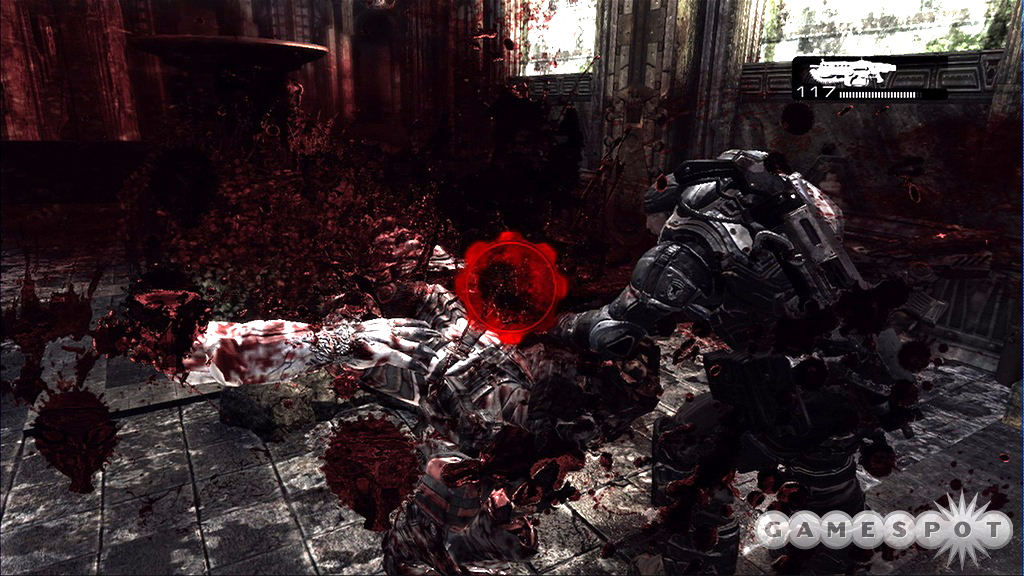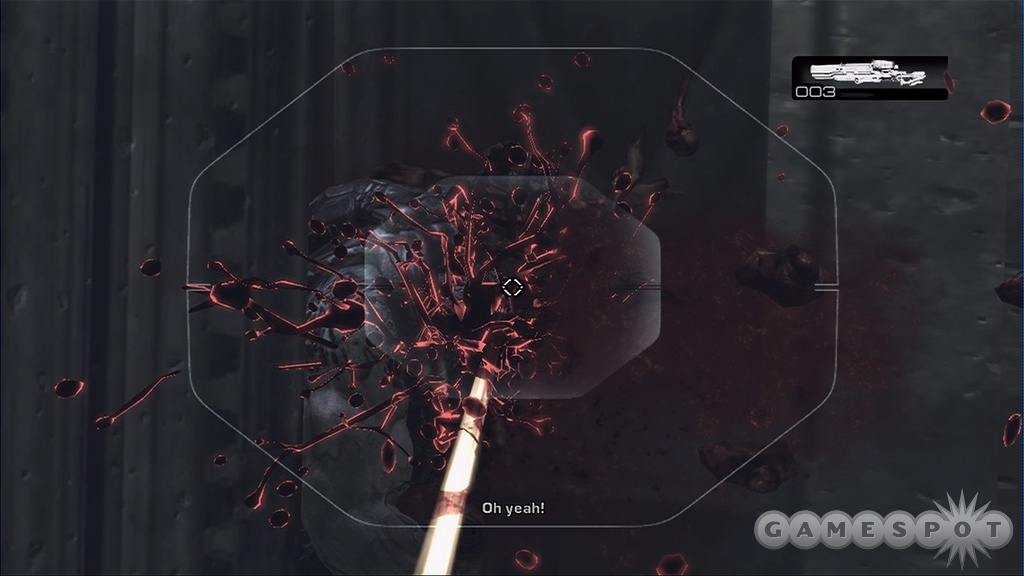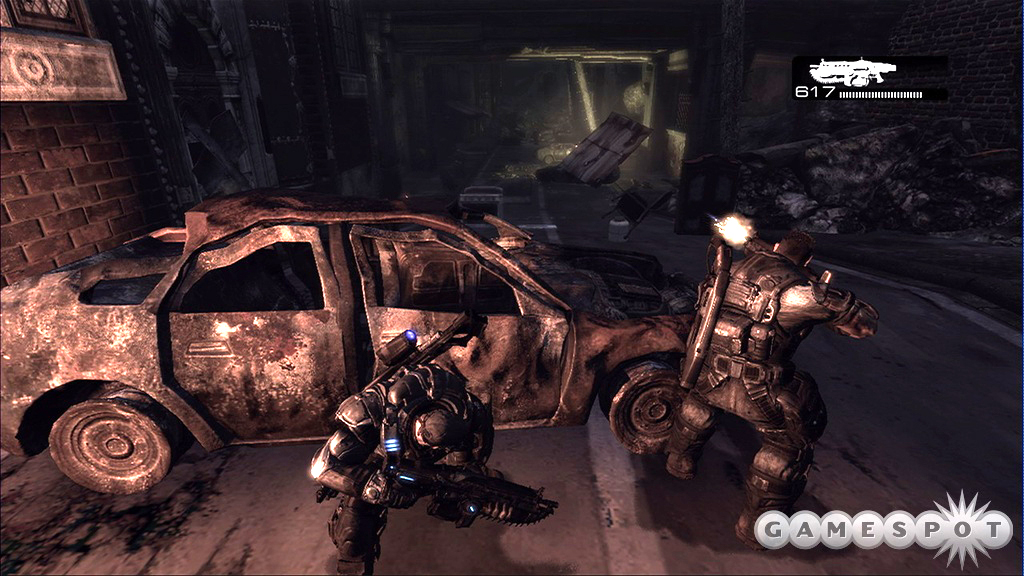In Gears of War, a slab of concrete is your best friend. And if that slab of concrete isn't around, you can always make do with burned-out cars, piles of metal, huge columns, or even the ever-popular wall next to a doorway. Why are these inanimate objects so friendly? Because if you aren't hiding behind something in Gears of War, you might as well be dead. Microsoft and Epic have teamed up to create this wicked game of hide-and-seek with high-powered future guns, which delivers one of the most heart-pounding and graphically thrilling experiences of the year. If its exciting campaign doesn't rope you in, chances are the team-based multiplayer will--either way, Gears of War is downright amazing.

The game's campaign tells the tale of a man named Marcus Fenix. He, like the other soldiers around him, is an extremely thick dude that very clearly doesn't have time to bleed. The game immediately sets an action movie-like tone, complete with an interesting post-apocalyptic world that's been overrun by a mysterious force called the Locust. Marcus is a former soldier for the Coalition of Organized Governments, or COG. Their soldiers wear ridiculously huge, bulky armor, but can't be bothered to wear helmets. They're just that tough. Or stupid. Either way, Fenix is a former soldier that's been branded a traitor and locked away, but he's busted out of prison at the opening of the game, to help in the fight against the Locust. After a brief tutorial level where you and Dom, the soldier that busted you out, make your way out of the Locust-infested prison and, yes, get to the chopper, you're connected with the other members of Delta Squad and sent out to find Alpha Squad, which is both missing and supposedly in possession of a device that could turn the tide of the war. The game's story isn't very deep, and aside from a very brief mention in the front of the manual, it doesn't really bother to fill you in on the details behind the conflict or the main character's incarceration. The lack of exposition feels like a missed opportunity to make the characters and the setting even more compelling, and there are parts of the game that seem like they were built specifically to make room for some kind of flashback sequence, but the gameplay is so sharp that you probably won't care.
You'll fight a decent variety of enemies in Gears of War. Most of the Locust are humanoids, with minor visual distinctions between the standard troops, ones with shotguns, and so on. Later on, you'll fight some different-looking humanoid-style enemies that are armed with explosive torque bows, and there are plenty of other critters to face--some small, some screen-filling. They all use slightly different tactics, but the same basic rule applies: Wait for them to pop their heads (or other weak points) out and attempt to shoot it off. The enemy response to your actions has its great moments, but it also has its problems. Enemies hiding behind cover tend to not react when they get hit. From time to time, you might catch the back of an enemy peeking just over a piece of cover, and if you start shooting it, he'll usually just sit there and let you drill him to death. But in spite of its few problems, the action is tense and extremely enjoyable.
Gears of War consists of a large series of pitched battles between your squad and the enemy forces. If you leave your fool head popped up for too long, it'll get shot off every single time, so the proper place for you is tucked behind a wall or some other piece of cover. The cover mechanics work very naturally, making it easy to stick to a wall, pop up or around to take shots at the enemy, and get back down safely. Moving between nearby pieces of cover is also very easy to manage.
This isn't the first time that taking cover has been a focus of gameplay--the mechanics work very similarly to a fairly obscure PlayStation 2 game from Namco called kill.switch. But no game has made this sort of gameplay quite so exciting. One of the greatest feelings in this game is that when you pop out to take a shot, you immediately feel like you're taking your life into your own hands, because the enemy is very good at opening fire the second they see you and you'll see those bullets heading your way. This formula remains thrilling from start to finish, though boss fights and a pretty neat vehicle section help to break up the action.
Thankfully, one shot won't kill you, in most cases. The health meter takes the form of a skull and gear icon that appears onscreen in pieces as you take damage. If it's completed, that means you took one hit too many and you're history. But if you can avoid getting shot for a few seconds, the gear fades away and you're restored to full health. It's a much quicker recharge than something like Halo's energy shields, and this helps keep the action moving while reinforcing that you really need to play cautiously.
You'll usually have three other guys in your squad, but they usually aren't much help. They're good for distracting enemies, and they'll take down a few here and there, but they also tend to get dropped a lot. You can revive them, if you can get over to them and hit the X button, but usually it's easier to just finish the fight yourself, which brings them all back without exposing you to the same enemy fire that took them down in the first place.

Gears of War offers two difficulty settings right off the bat, and a third unlocks when you beat the game. The game defaults to the easiest setting, called casual. On this setting, taking cover only becomes important when you're up against heavy odds or later in the game, when the enemies get tougher. The middle setting, hardcore, feels just right at first--you need to take cover, but you can usually pop up and take shots without immediate punishment. But near the tail end of the game, both difficulties ramp up quite a bit. Hardcore starts to get a little unmanageable. Casual gets to be about as hard as the hardcore setting is near the beginning of the game. And once you unlock insane, you'll find that it's aptly named, though not impossible. Overall, the difficulty feels like it could have used a bit more tuning, or another setting that finds the sweet spot between casual and hardcore. But since you can select your difficulty each time you load up your game, it's easy to set it down to casual if you get stuck at a certain checkpoint, then raise it back up once you've made progress. Making your way through the campaign should take most players somewhere from about 10 to 12 hours, depending on the difficulty.
The game has achievements for finishing each of the five acts on each of the three difficulties, and they stack, so if you beat an act on hardcore, you get the casual points, as well. It only seems to keep track of what difficulty setting you're on when you finish the act, so all this switching around won't cause any trouble on that front, either. The game's achievements are pretty good, with a smart mix of points you'll get for simply playing through the game and some more esoteric ones, like points for playing as Dom in co-op, points for perfectly reloading your weapon many times in a row, doing well online, and so on. None of the points seem that far fetched, but you also won't have the full thousand during your first couple of days with the game, either.
While the campaign is fine and good alone, it's even better when you're playing with another player. You can do so via a split-screen or over Xbox Live, and the good news is that you can continue the campaign from where you've played in the single-player, so you can use any mix of single or cooperative play to get through without having to replay missions. The second player takes on the role of Dom, and the game is both more entertaining and significantly easier when playing with a partner. That's because when players die in co-op, they can be revived, provided they haven't been blown to bits or their deaths don't take place during one of the few times when the team splits up, separating the two human players. Online, the co-op behaves quite smoothly, and the graphics in split-screen mode appear to be just as good as they are when you're playing alone. About the only negative aspect of co-op play is that if a player drops out of an online game, the other player is forced to quit back to the main menu. A more seamless drop-in/drop-out setup would have been cool.

A big part of making any shooter memorable is the design of its weapons. Gears of War has some very satisfying weaponry that really make the game stand out. The machine gun you're going to use for most of the game is the Lancer, and in addition to it being a fast-firing death dealer, it also has a unique melee attack in the chainsaw bayonet. Yes, a machine gun with a chainsaw mounted to the bottom of it is just as awesome as it sounds, though since most of the enemies are content to hide behind cover and mow you down if you attempt to get close, you don't get to use it as often as you might like. But when you do, it's a terrific display of great, splashy blood effects. The other weapons in the game aren't quite as flashy, as you'll get a standard sniper rifle, shotgun, rocket launcher, some grenades, and so on. But you'll also get to use something called the Hammer of Dawn, which is an orbital satellite that beams down hot, fiery death from above when you paint a target. But the catch is that the satellites have to be lined up above your position and you have to be outside for it to work, so it's only available in a few very specific situations during the campaign. You can carry four different weapons, but you'll always have slots reserved for a pistol and for grenades, so you have to make choices about which two main weapons you'll carry around with you.
Another really cool facet of the gameplay is that there's a trick to reloading your weapon. By default, reloads take a set amount of time and aren't anything flashy. But if you look just below the gun indicator on the screen, you'll see a line sweeping across a bar with a couple of different colors on it. That's the trick. A button press stops the meter. If you stop it in the gray area, the weapon reloads faster. If you stop it in the tiny white zone, you'll reload and all the bullets you just fed into your weapon will do more damage. But if you miss and hit it in the black, the gun jams and takes even longer to reload. It's a fascinating risk-versus-reward scenario that isn't difficult to master, but when you're under fire in a tense situation, you're still likely to screw it up now and then.
In addition to the single-player and co-op play, Gears of War has a team-based multiplayer mode for up to eight players. The four-on-four action is also round-based with no respawns, though like in the co-op game, you can revive other players when they go down. On the other side, though, that means you need to pump a lot more rounds into your enemies after they go down, just to make sure they stay down. Or, alternately, you can run up on their downed body and hit the X button, which delivers a very satisfying life-ending boot to your foe's head. For as much fun as the weapons are in single-player, they're actually more exciting here. The Hammer of Dawn becomes a pretty hilarious addition to the game, and you'll get to use that chainsaw more frequently against unsuspecting players thanks to the way the maps offer multiple ways to get to the same location. The key to multiplayer is to never work alone so that you can always have someone around to revive you and vice versa. Two players rolling up on one player usually (though certainly not always) results in the single player getting decimated. One of the other players may go down, but that's nothing a revival won't fix. The game's 10 maps offer a good variety, and you can mix the action up a bit by changing out the weapons that appear in the map. You can play in three different modes. Warzone is a standard team deathmatch. Assassination puts one player in the leader role and the other three players must fight as protectors. Execution forces you to kill opposing players yourself--if you let them sit there and bleed, they can hammer the A button to revive themselves. With a good number of maps and exciting action, this game appears to have some longevity to it online. If you like, you can also play over a LAN via system link, or locally--though local multiplayer is limited to two players, which isn't too exciting.

Consider Gears of War to be the game that raised the bar for how console games should look from here on out. The character models are thick and look outstanding. The gray, war-torn environments are nicely varied throughout the game, and the game is full of amazing standout visual moments, such as a train sequence where you see that the sky is full of ink left behind by flying Locust enemies, blocking your view of the stars just enough to prevent you from busting out the Hammer of Dawn. Or, when you get to an underground mine and see a lot of molten, glowing lava all around you. Or, anytime you get to use the chainsaw on anything, ever. Or, the way the camera gets down low and starts shaking like a wartime documentary whenever you start running. It all looks absolutely amazing, from the animation to the game's over-the-top blood effects.
The game also runs at a very steady frame rate during gameplay. The cutscenes, however, are rendered in real time, and when the action really gets heated in some of the sequences, the visuals chop up. The music in Gears of War is appropriately cinematic and really helps carry the action-movie style that the game is shooting for. The dialogue also gives off an action-movie vibe, mainly because most of it is totally meatheaded. The COG soldiers aren't scientists--they're dumb, strong soldier boys that are at home when they're behind the trigger. As a result, almost all of the dialogue is appropriately gruff and filled with the sort of "let's rock!" enthusiasm that you'd expect from a team of hardcore shooters. The weapons are also enhanced by great sound effects. The squish of flesh being ripped apart by the chainsaw, in particular, is outstanding.
Gears of War is a game that capitalizes on all of the promises made by the next generation of gaming. It looks more than a few steps beyond what consoles have been doing to this point, and the gameplay is supremely fulfilling from start to finish in all of its various modes. While there have certainly been plenty of similar shooters before it, the game's great weapons, amazing graphics, and absolutely thrilling action make it stand out from the pack in a big, big way.